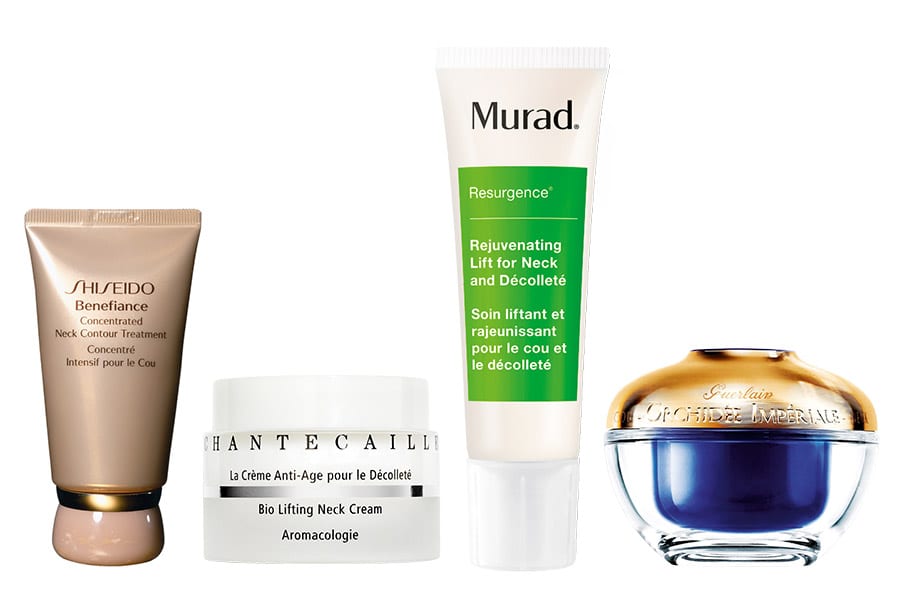The skin of the neck and décolletage is one of the first places on the body to show signs of sun damage and ageing. Help to maintain a youthful, healthy appearance with our expert tips on caring for this delicate area.
In the beauty world, it’s often said that it’s the delicate skin around the eyes that reveals the first signs of ageing. And after slathering on eye cream to keep fine lines and wrinkles at bay, it’s our visage that tends to get all of the attention where our skincare routine is concerned. But as Clinic 42’s Dr Lynn Theron explains, after the eye area, it’s actually the skin of the upper chest that is most prone to showing the signs of sun damage and ageing. “Part of the reason for this is the difference in the architecture of our skin in this area, compared to, say, the face,” she says. Unlike the skin on our face, Theron says there are fewer hair follicles and a relatively low density of sebaceous glands. This means the area has reduced oil production, heals more slowly, and is generally more prone to scarring. “The neck and upper chest skin also contain fewer elastin fibres than facial skin, resulting in a weaker supporting structure to the collagen matrix,” she says. “Furthermore, there are fewer fatty structures under the skin to help support the less-elastic overlying skin.”
Skincare Solutions
As well as the changes that happen in our skin – for example, menopause and biological ageing – Theron explains there are a number of external factors that dictate how the skin on our neck and décolletage behaves. “Aside from … exposure to UV, movement of the skin envelope and the weight and position of breast tissue will also affect these wrinkles,” Theron says. Fortunately, fending off the signs of ageing and caring for the neck and décolletage isn’t all that different from caring for our face. Unsurprisingly, great sun protection is key to keeping the neck and chest skin healthy. “Our first ‘prescription’ would be a broad- spectrum, high sun protection factor sunscreen,” Theron explains. “At a minimum, SPF50 should be the go-to for this area. And when possible, cover the skin with clothing – bring on the polo-neck bikini!” she jests.
The second step is investing in good-quality skincare. “The key is using active, appropriate skincare for your skin type and concerns,” Theron explains. “Skincare that is loaded with … peptides and vitamins that protect, repair and rehydrate the décolletage area is crucial.” Vitamins A and C are must-haves in any thorough skincare routine, and Theron says they should be extended beyond the jawline as well. “Vitamin A helps to repair free radical damage caused by sun exposure, pollution and inflammation, whilst vitamin C treats and helps prevent pigmentation, and builds collagen – creating plumper and healthier skin,” she explains.
As for the steps you should be taking, just mimic what you’re doing with your face: cleanse, exfoliate, and use a treatment serum, moisturiser and sunscreen during the day. Theron also says it’s important to consider your skin type and concerns when it comes to the routine you’re intending to use. “Depending on the condition of your skin, in terms of its texture, hydration, discolouration and laxity, there are different treatment approaches available,” she says. She explains that women in their forties and fifties can benefit from the use of a more potent range in this area, due to the hormonal changes that tend to be occurring during this time. “As a result of hormone changes relating to menopause and comparative oestrogen deficiency, women in their forties and fifties are particularly prone to ageing in this area. There’s accelerated collagen and elastin breakdown – resulting in skin thinning, dryness, and other less desirable changes,” Theron says. As with any skincare concern, prevention is better than treatment – so Theron says if possible, it’s ideal to have a robust skincare regime sorted in the neck and décolletage area prior to these hormonal changes commencing.
Going Deeper
Once you’ve got your neck and décolletage skincare routine down pat, Theron says there are a plethora of in-clinic modalities that can help improve the appearance, texture and other features of ageing skin. “A common concern in this area is skin discolouration, sun damage and broken capillaries,” Theron says. “In the first instance, this is best targeted with an energy device approach, such as Intense Pulsed Light (IPL). This introduces wavelengths of light to the skin, which can target the pigment or vessels.”
Injectables, such as Botox and hyaluronic acid-based fillers, can be used to help reduce the appearance of fine lines in the area, too. “Botulinum toxin can have a smoothing effect on the décolletage by weakening the platysma bands,” Theron explains. “Hyaluronic acid fillers help replenish moisture in the top layers of the skin and reduce the appearance of fine lines, whilst plumping the skin.” Other modalities that can help minimise the appearance of ageing include radiofrequency devices, which help tighten skin through stimulating collagen production; threads, which are placed in the skin to form a structural matrix that stimulates cellular activity; and platelet-rich plasma, a brand-new modality that encourages healing and plumps and rehydrates the deeper layers of the skin. “As can be seen, all the modalities aim to stimulate and increase collagen production – the process that rapidly declines from your forties onwards,” Theron says. “Invest in this area. It will pay off hugely in the long term.”

Try these for a healthy, luminous neck and decolletage: Shiseido Benefiance Concentrate Neck Contour Treatment Concentré ($96); Chantecaille Bio Lifting Neck Cream ($286 from Mecca Cosmetica); Murad Rejuvenating Lift for Neck & Décolleté ($125); Guerlain Orchidée Impériale The Neck And Décolleté Cream ($605).
Sleeping Beauty
If you’ve ever woken up with more wrinkles on your chest than what you went to bed with, you’re not alone. “Morning wrinkles are likely due to your sleeping position,” Theron says. “If you sleep on your side, and your breast/chest tissue droops past your midline due to the effects of gravity, these lines will be more prominent. Sleeping on your back or on two or three pillows can decrease these lines, as can silicone pads that are affixed to the area at night.”
Scents & Sensibility
When we reach for our favourite perfume, it’s usually our neck or décolletage that gets the first spritz. But Theron says that it might be time to rethink how and where you apply your fragrance. “Some perfumes – for example, bergamot – may directly stain the skin, and for many, the high alcohol content of perfumes can cause mild contact dermatitis or inflammation within the skin,” explains Theron. Certain fragrances can also cause photosensitivity – UV light can interact with ingredients in fragrances which can cause allergic reactions and increase sensitivity to the sun.






